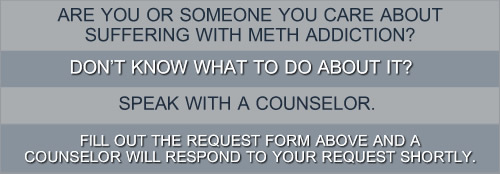
Meth Abuse Treatment
Methamphetamine (meth) is a dangerous and highly addictive central nervous system stimulant and its abuse has both short- and long-term negative consequences. Meth is cheaply produced in illegal and clandestine laboratories with easily available ingredients. This increases its potential for widespread abuse. Though methamphetamine is similar to cocaine in structure, they differ in the manner they work in the nerve cells. Cocaine is completely metabolized in the body and quickly removed when compared to meth. Meth stays for a longer duration in the body in an unchanged form and this explains its lasting stimulant effect.
Meth abuse takes a longer time to treat and the drug user may need more than one treatment session to give up using the drug permanently. Other than heroin, meth is considered to be one of the most addictive drugs. To stop using the drug, a meth addict needs to have professional assistance and specialized treatment. Meth abuse treatment is likely to be successful only if carried out by a qualified healthcare professional in the field.
The meth abuse treatment program is elaborate and is aimed at stopping both the physical and psychological dependency of the affected individual on the drug. The treatment spectrum is broad in that it is not only designed to treat the withdrawal symptoms that occur when the addict stops using meth, but also the underlying factors that prompted abuse in the first place. The detailed method of treatment and its outcome is based on these factors. In this context, the length of time for which the individual has been abusing the drug and the age of the drug user are important.
The first stage of meth abuse treatment is the drug detoxification. This stage involves cleansing the body of all the harmful substances that have been ingested by the addict. The first step in the detoxification process is the evaluation of the addict. This step involves collecting all the background information: the reasons that led the drug user to start using the drug in the first place, family and social background, etc. Many a time it is seen that the very reason that prompted them to use the drug is likely to send the abuser into a relapse, i.e., when he/she goes back into abusing the drug.
The second step also called the stabilization stage involves the actual detoxification. The detoxification process may be carried out with or without the use of medications. This depends largely on the extent of meth abuse. Currently, there are no specific pharmacological treatments that would directly cure dependence on methamphetamine or other similar drugs.
Depression is frequently observed to occur in those meth users who have recently stopped taking the drug. This accompanying depression is treated using certain anti-depressant drugs. Intoxication of the body with meth is best treated in a quiet and safe environment. In cases where the drug addicts display extreme panic or excitement, benzodiazepines are administered to reduce anxiety. In other cases where meth abusers exhibit psychoses, neuroleptic drugs used on a short-term basis have been seen to produce favorable results.
Some medications that are approved by the FDA for treatment of other medical disorders may be useful in treating meth abuse. Bupropion, an antidepressant drug, was seen to reduce the high caused by meth as well as cut down the cravings associated with consistent use of the drug.
The final phase is the recovery phase. Currently, the most effective forms of treatment for meth abuse are behavioral therapies that include cognitive behavioral treatment and contingent management interventions.
The Matrix Model approach is a popular treatment methodology for meth abuse treatment that combines behavioral therapy for the addict, family counseling, individual counseling, drug testing and medication, and encouragement to take part in non-drug related group activities. The contingency management interventions mostly deal with offering incentives for staying away from meth and continuing to be in meth abuse treatment.
The Matrix Model was initially developed in the 1980s as a method of treatment for cocaine addiction. The treatment period ranges from four to six months and is a form of outpatient cognitive behavioral therapy. It is designed to have at least three individual or group therapy sessions per week. Patients are coached in many aspects during their recovery phase in this model. They are taught to abstain from risky behavior that may trigger a relapse and manage their cravings. All along they are educated about drug addiction and its negative consequences. Presence of meth in urine is tested at regular intervals. Some statistics reveal that the addict is about 50 to 60% drug free at the end of one year of treatment following the Matrix Model. Though the success rate is not as high as recovery from alcoholism, the rate is higher than average according to experts.
Many other treatment methods for meth abuse vary in length (therapy may extend from one to six months), intensity of sessions (may vary anywhere between 1 and 13 hours per week), population (some programs are designed exclusively for women), etc. Many treatment programs involve counseling of the addict to help develop better self esteem and assertiveness. Some of them also focus on family support and spirituality. Whereas some of the programs are very rigorous and conform to a set pattern, there are others that can be customized to suit the needs of every individual patient.
There are meth abuse treatment inpatient procedures as well. Typically, they are a 28-day residential therapy program that focuses mainly on detoxification and coaching the patient on self-help strategies. Though such programs were used for alcoholics in the 1980s, they are becoming more popular. Similarly longer-term residential programs of up to six months that were designed initially used by heroin addicts, they are increasingly used for meth abuse treatment with sufficient modifications in recent times.
Clinical trials of pharmacological products for meth abuse treatment are continuing. Among the compounds being tested are calcium-channel blockers that may serve to prevent release of excessive amounts of neurotransmitters, anti-nausea drug Zofran that may help to prevent relapse, and antidepressant drugs that may increase production of dopamine that is abysmally low in people who abstain from using the drug. Some medications are also being developed to reverse the neurological damage inflicted by regular use of meth. Studies on selegeline and vitamin E are being conducted in this context. Antidotes for meth that would combat overdoses of the drug are also being researched.
Those addicts who continue to be in meth abuse treatment see significant improvements after a year or two. As meth addicts also experience significant health deficits due to the addiction, it is important that they receive appropriate medical care to treat these underlying conditions for effective recovery.
- Questions?
